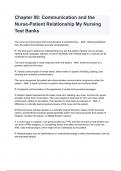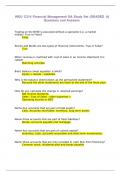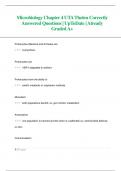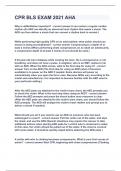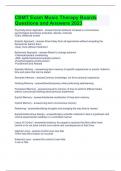Chapter 08: Communication and the
Nurse-Patient Relationship My Nursing
Test Banks
The nurse can best ensure that communication is understood by: - ANS obtaining feedback
from the patient that indicates accurate comprehension.
R: The best way to determine understanding is to ask the patient. Factors such as anxiety,
hearing acuity, language, aphasia, or lack of familiarity with medical jargon or routines can all
contribute to misunderstanding.
The nurse recognizes a verbal response when the patient: - ANS writes the answer to a
question asked by the nurse.
R: Verbal communication involves words, either written or spoken. Nodding, sobbing, and
moaning are nonverbal communication.
The nurse recognizes the patient who demonstrates communication congruency when the
patient: - ANS is tearful and slow in speech when talking about her husbands death.
R: Congruent communication is the agreement of verbal and nonverbal messages.
A Hispanic patient approaches the Asian nurse and, standing very close, touches the nurses
shoulder during their conversation. The nurse begins to step back to 18 to 24 inches, while
smiling and nodding to the patient. This situation is most likely an example of: - ANS a
difference in culturally learned personal space of the nurse and the patient.
R:Personal space between people is a culturally learned behavior; Asians, North American
natives, and Northern European people generally prefer more personal space than people of
Hispanic, Southern European, or Middle Eastern cultures.
5. A nurse says to a patient, I am going to take your TPR, and then Ill check to see whether you
can have a PRN analgesic. In considering factors that affect communication, the nurse has: -
ANS used medical jargon, which might not be understood by the patient.
R: Medical jargon such as abbreviations or medical terminology is often misunderstood, even by
well educated people.
, 6. A nurse using active listening techniques would: - ANS use nonverbal cues such as leaning
forward, focusing on the speakers face, and slightly nodding to indicate that the message has
been heard.
R:Eye contact is a culturally learned behavior and in some cases may not be appropriate.
Probing questions or finishing the patient's sentence is not part of active listening and is
detrimental to an interview.
7. When the patient says, I dont want to go home, the nurses best therapeutic verbal response
would be: - ANS You dont want to go home?
R: The use of reflecting encourages the patient to expand on his or her feelings or thoughts.
8. To begin talking with a newly admitted patient about pain management, the nurse would most
appropriately state: - ANS Tell me about the pain youve been having.
R:An open-ended question allows the patient to express his or her feelings or needs.
9. When a patient begins crying during a conversation with the nurse about the patients
upcoming surgery for possible malignancy, the nurses most therapeutic response would be: -
ANS Here is a tissue. Id like to sit here for a while if you want to talk.
R:Offering self, or presence, and accepting a patient's need to cry is supportive.
10. To enhance the establishment of rapport with a patient, the nurse should: - ANS act in a
trustworthy and reliable manner; respect the individuality of the patient.
R:Trust and reliability, as well as conveying respect for the individual, all promote rapport.
Identifying oneself is important but in itself does not promote rapport. Sharing personal
experiences or divulging the confidential nature of other patients' conditions is not appropriate in
the nurse-patient relationship.
11. The nurse explains that the therapeutic nursepatient relationship differs from the social
relationship because: - ANS the nurse-patient relationship ends when the patient is discharged.
R:The nurse-patient relationship is limited to the patient's stay in the facility and is focused on
the patient. A social relationship may have goals or needs and does require trust and sharing of
life experiences.
12. The nurse has selected an outcome for the patient to eat all of the food on the breakfast tray
each day. Assessing that the patient has eaten all of the breakfast, the nurse would give positive
feedback by saying: - ANS Hurray! You finished your whole meal! What would you like for
tomorrow?

